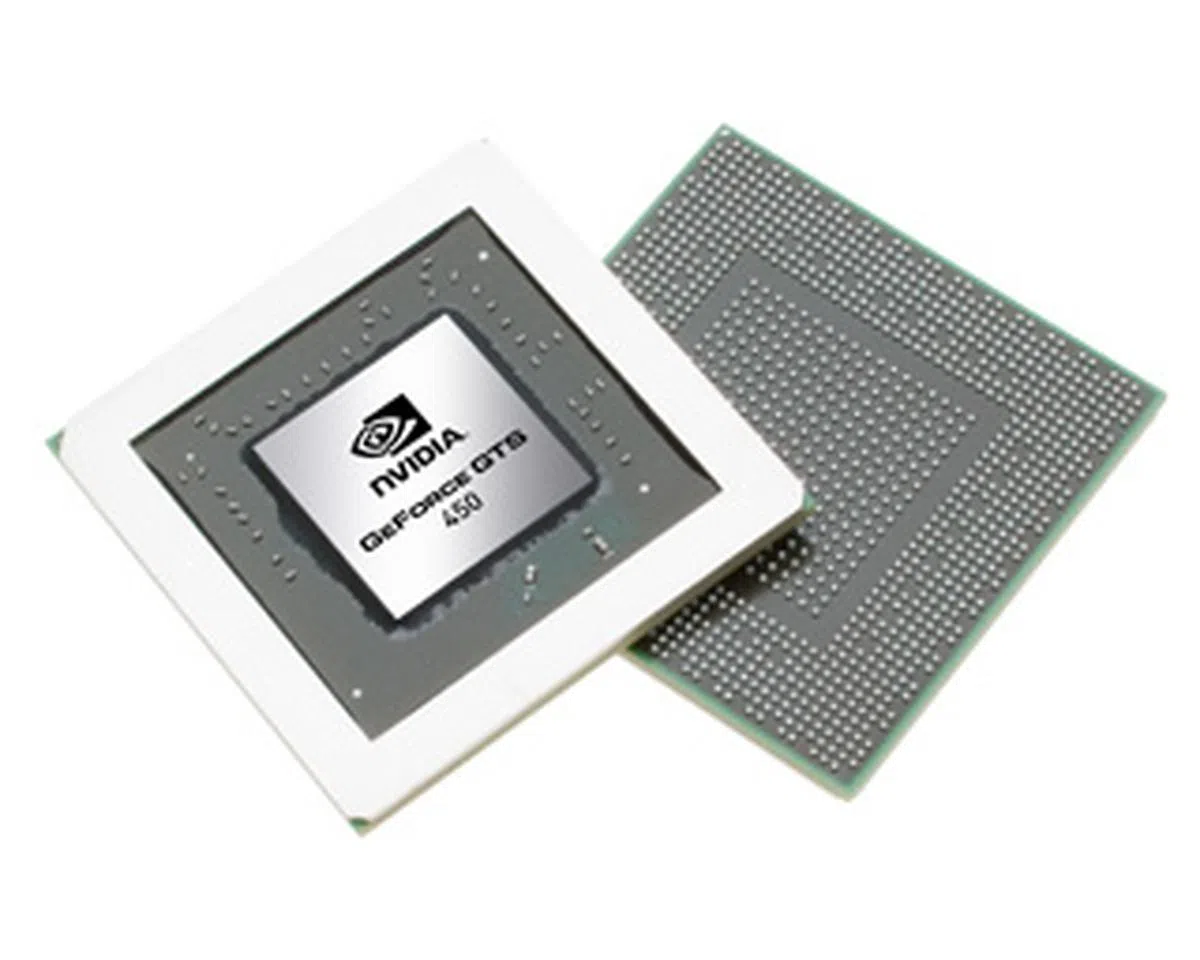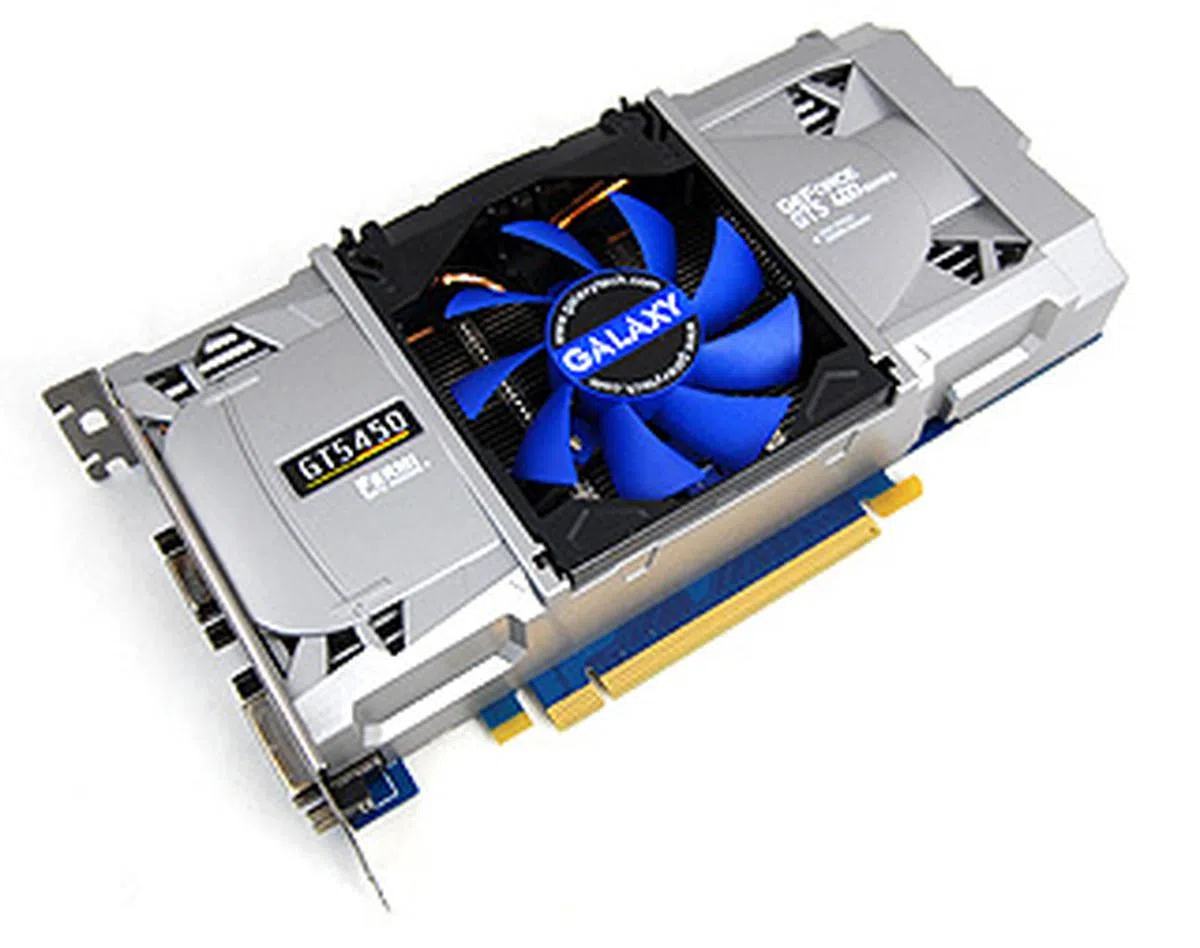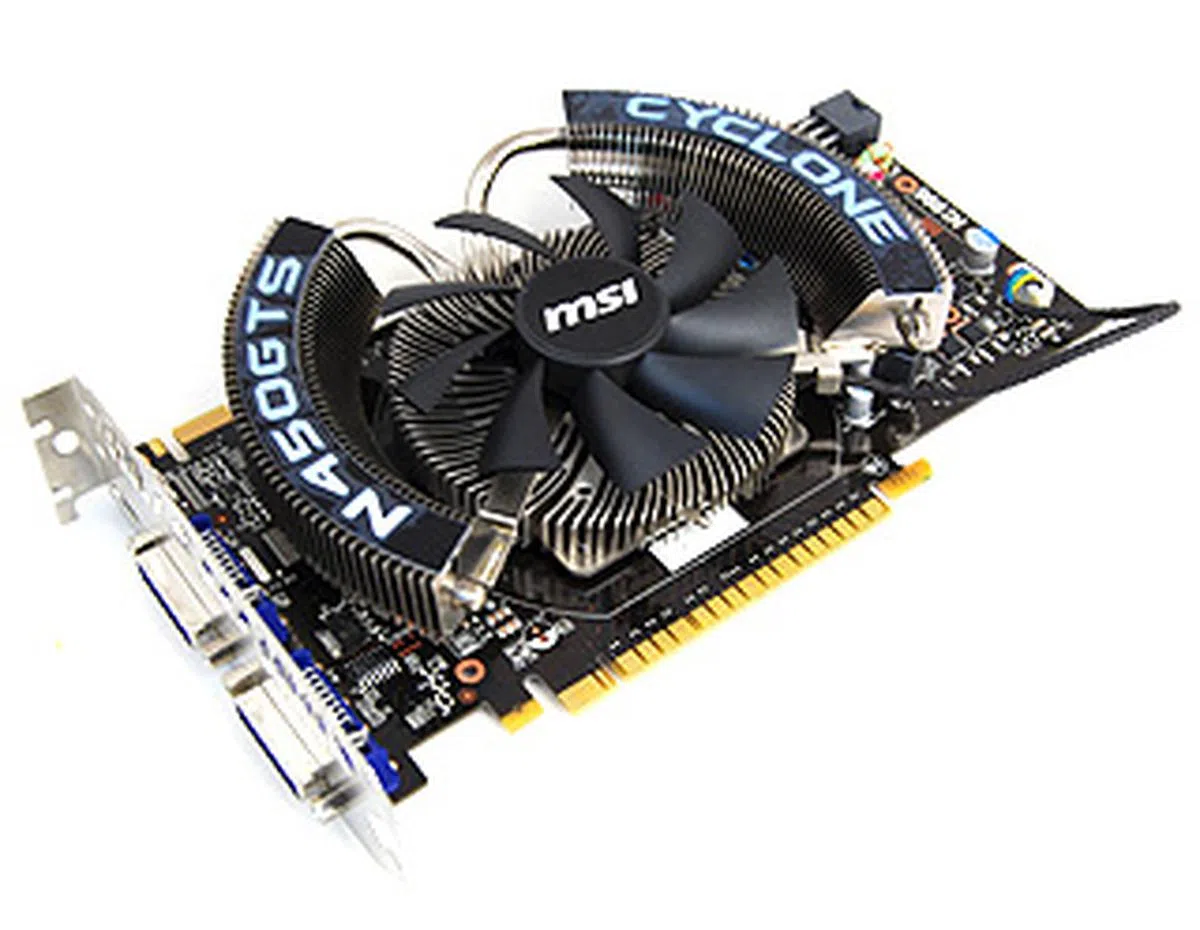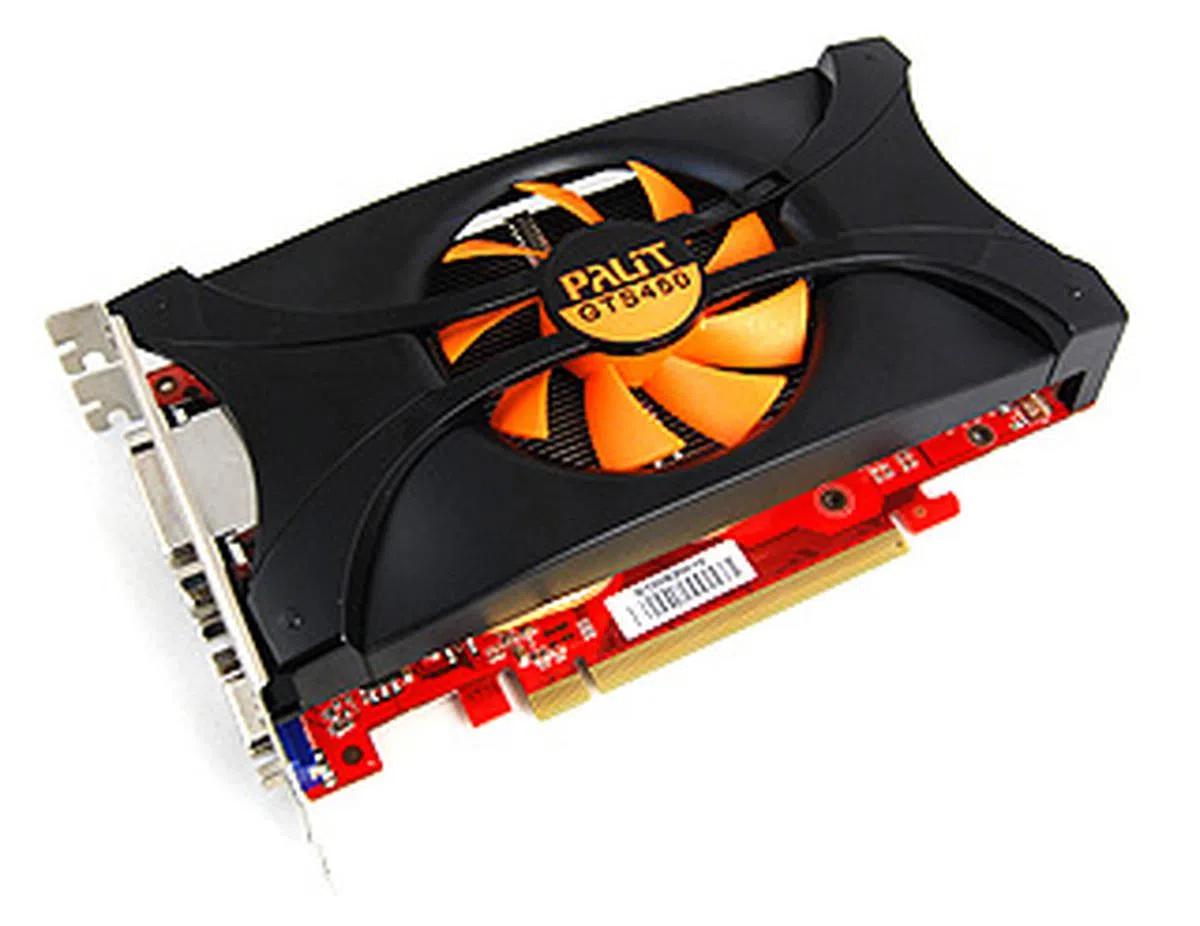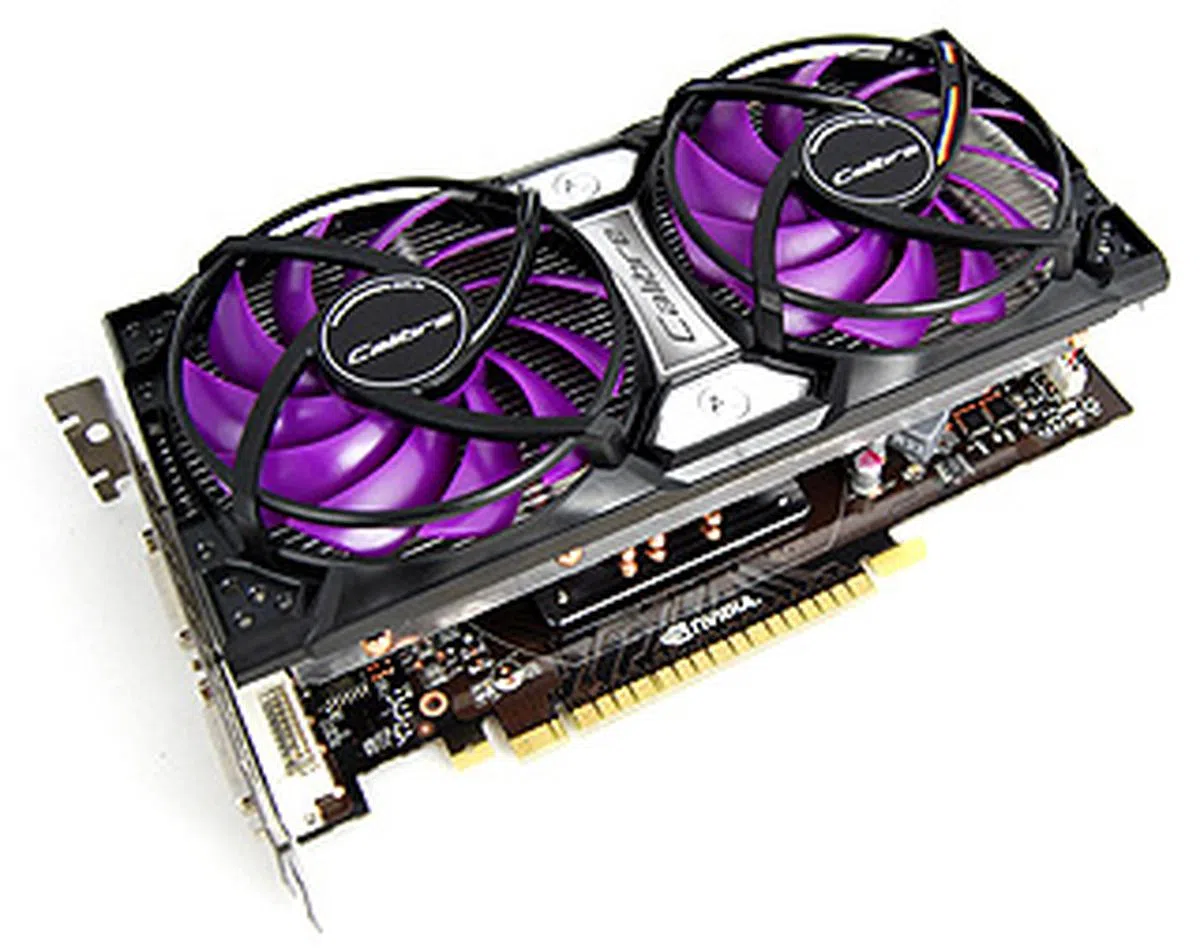NVIDIA GeForce GTS 450 - Going For the Mainstream Jugular
NVIDIA is expanding their Fermi lineup with the GeForce GTS 450. Targeted squarely at mainstream and casual gamers alike, NVIDIA says it'll offer unparalleled performance for its price. We take four retail custom edition cards from Galaxy, MSI, Palit and Sparkle for a spin to see if this is the SKU that everyone's been waiting for.
By Kenny Yeo -
Going For the Mainstream Jugular
Despite rave reviews received by the GeForce GTX 460, NVIDIA registered a pretty lackluster second quarter for financial year 2011. Revenue was down by over US$220 million and overall the company suffered a loss of $105 million. NVIDIA attributes this to the weakened demand for graphics cards, which is odd, because as far as we can tell, it seems that many people we knew were buying GeForce GTX 460 left, right and center in a bid to get their systems ready for StarCraft 2.
Nevertheless, the GeForce GTX 460 marked a turn in fortunes as far as Fermi cards were concerned. Before the GeForce GTX 460, the Fermi-powered GeForce GTX 480, GTX 470 and GTX 465 were fast, but extremely power hungry and hot to run. However, the GeForce GTX 460 was the first Fermi-powered card to combine performance and acceptable levels of power consumption and heat into one neat package.
Soldiering on in attempts to gather a larger piece of the mainstream gaming pie, NVIDIA has just introduced to us the new GeForce GTS 450. Set to compete directly with ATI’s Radeon HD 5750 and designed to specifically tackle screen with the popular 1650 x 1050 resolution, the GeForce GTS 450 will retail at around US$129, making it very appealing to gamers on a shoe-string budget.

The GeForce GTS 450 will employ the use of the all-new GF106 chip, which promises better power efficiency and lower running temperatures.
Like the GeForce GTX 460 before it, GeForce GTS 450 will pack an all-new GF106 chip that is smaller than the GF104 that powers the GTX 460. And on paper, this should mean a more power efficient and less hot chip.
Architecturally, the GF106 in the GeForce GTS 450 is similar to the older GF104 in that will pack 48 CUDA cores per SM (streaming multiprocessor). The GeForce GTS 450 will also have four SMs, giving it a total of 192 CUDA cores, 32 texture mapping units and 16 raster operating units. This might not seem like much when compared to the 336 CUDA cores of the GeForce GTX 460, but the GeForce GTS 450 makes up for that by retaining the use of ultra-fast GDDR5 memory, albeit on a narrower 128-bit memory bus width, and higher clock speeds. To be specific, a GeForce GTS 450 in stock form will run at 789MHz at the core, 1566MHz at the shaders and 3608MHz DDR at the memory. The core clock speeds, in particular, are pretty high.
Up to this point, the GeForce GTS 450 looks promising, and while the hardware certainly looks up to task, we are a bit worried that the high clock speeds will affect its power draw figures adversely.
Anyhow, we have four GeForce GTS 450 cards from Galaxy, MSI, Palit and Sparkle. Fresh from the factory, we can’t wait to put them through our tests to find out how the new GeForce GTS 450 will perform. But first, here’s quick look at how the GeForce GTS 450 model stacks up against its closest rivals.
Model | NVIDIAGeForceGTS450 1GBGDDR5 | NVIDIAGeForce GTX460 1GB / 768MBGDDR5 | NVIDIAGeForce GTS250 1GBGDDR3 | ATIRadeon HD5770 1GBGDDR5 | ATIRadeon HD5750 1GBGDDR5 |
Core Code | GF106 | GF104 | G92b | Juniper XT | Juniper PRO |
Transistor Count | 1170 million | 1950 million | 754 million | 1040 million | 1040 million |
Manufacturing Process | 40nm | 40nm | 55nm | 40nm | 40nm |
Core Clock | 783MHz | 675MHz | 738MHz | 800MHz | 700MHz |
Stream Processors | 192 Stream Processors | 336 Stream Processors | 128 Stream Processors | 800 Stream Processing Units | 720 Stream ProcessingUnits |
Stream Processor Clock | 1566MHz | 1350MHz | 1836MHz | 800MHz | 700MHz |
Texture Mapping Units (TMU) or Texture Filtering (TF) units | 32 | 56 | 64 | 40 | 36 |
Raster Operator units (ROP) | 16 | 24 | 16 | 16 | 16 |
Memory Clock | 3600MHz GDDR5 | 3600MHz GDDR5 | 2200MHz GDDR3 | 4800MHz GDDR5 | 4600MHz GDDR5 |
DDR Memory Bus | 128-bit | 192 / 256-bit | 256-bit | 128-bit | 128-bit |
Memory Bandwidth | 57.6GB/s | 86.4 / 115.2GB/s | 70.4GB/s | 76.8GB/s | 73.6GB/s |
PCI Express Interface | PCIe ver 2.0 x16 | PCIe ver 2.0 x16 | PCIe ver 2.0 x16 | PCIe ver 2.0 x16 | PCIe ver 2.0 x16 |
Molex Power Connectors | 1 x 6-pin | 2 x 6-pin | 1 x 6-pin | 1 x 6-pin | 1 x 6-pin |
Multi GPU Technology | SLI | SLI | SLI | CrossFireX | CrossFireX |
DVI Output Support | 2 x Dual-Link | 2 x Dual-Link | 2 x Dual-Link | 2 x Dual-Link | 2 x Dual-Link |
HDCP Output Support | Yes | Yes | Yes | Yes | Yes |
Street Price | Launch Price: US$129 | US$229 (1GB) / US$199 (768MB) | ~US$110 | ~US$160 | ~US$130 |
The Galaxy GeForce GTS 450 Super OC
Galaxy’s customized GeForce cards have always been one of the fastest around and the their new GeForce GTS 450 Super OC continues the tradition by sporting really aggressive clock speeds. This card is clocked at an impressive 888MHz at the core (lucky number), 1776MHz at the shaders and 4000MHz DDR at the memory. This is substantially more than a reference card’s equivalent 789MHz, 1566MHz and 3608MHz DDR.
Also, the card comes with Galaxy’s unique “flip-fan” custom cooler, which has an easily detachable fan for easily maintenance. Our experience with Galaxy’s unusual cooler tells us that while it may be special, it’s not the most effective cooler on the market, as their cards that are fitted with this fan usually run a tad hotter. It’ll be interesting to see if Galaxy has done anything to improve on them.

The Galaxy GeForce GTS 450 Super OC sports the same detachable flip-fan cooler that we've seen on their custom designed GeForce GTX 460 and GTX 470 cards.

Rather than offer the usual twin DVI ports, Galaxy has decided instead to substitute one of them for a traditional VGA one. Also, they have included a proper HDMI port as opposed to a mini-HDMI one that is seen on so many Fermi cards.

The fan can be lifted as such to access the heatsink below for easily maintenance.
The MSI N450GTS Cyclone
MSI is offering only custom designed versions of the GeForce GTS 450 and their first card from this SKU is the N450GTS Cyclone. Naturally, the card is factory overclocked at a respectable 850MHz at the core, 1700MHz at the shaders and 4000MHz DDR at the memory.
And to complement the higher clock speeds, MSI has fitted their own unique Cyclone cooler. The Cyclone cooler has been seen on various MSI cards and it has proved itself to be an excellent cooler that marries the two important cooler attributes of cooling efficiency and attractiveness.

The distinctive Cyclone cooler makes a return in MSI's N450GTS Cyclone card.

The MSI card sports the usual twin DVI ports and single mini-HDMI port, so nothing interesting to report here.

The Cyclone cooler is one of the funkier looking custom coolers out there and and if there's anything it isn't short of, it's cooling fins.
Palit GeForce GTS 450 Sonic Platinum
The “Sonic Platinum” moniker is only bestowed on Palit’s fastest cards and in this case, the Palit GeForce GTS 450 Sonic Platinum is well deserving of the title thanks to its incredible and impressive clock speeds of 930MHz at the core, 1848MHz at the shaders and 4000MHz DDR for the memory. This is a whopping increase over a reference card’s comparable 789MHz, 1566MHz and 3608MHz DDR. Our only fear is that the card might run hot since the compact cooler it uses does not look up to the task of coping with such high clock speeds.

Despite its insanely high clock speeds, the Palit GeForce GTX 460 Sonic Platinum sports a very simple and plain looking custom cooler.

The Palit card scores top marks with its video output connectivity, offering no less than two DVI ports, a VGA port and a proper HDMI port.

Unlike the other three cards, Palit's card is remarkably simple.
The Sparkle Calibre X450G
The Sparkle Calibre X450G is factory overclocked at 850MHz at the core, 1700MHz at the shaders and 3800MHz DDR, which is respectable even though it is not the fastest, and should give the Sparkle card a good boost in performance. However, what’s more eye-catching is its massive 2.5-slot, twin fan Accelero Twin Turbo Pro custom cooler from cooling specialist Arctic. It’ll be interesting to see how warm the card will run with a cooler this elaborate.

The Sparkle Calibre X450G is outfitted with a massive dual-fan Accelero Twin Turbo Pro cooler from Arctic.

Twin DVI ports and a single mini-HDMI port is all that is offered by the Sparkle card in terms of video output.

Do you spot something missing? The cooler was actually designed with four heat pipes, but it seems that the Sparkle card is missing one as you can see from the gaping hole towards the left of the heatsink.
Test Setup
The cards will be tested using our high-end X58 system with the following specifications:
- Intel Core i7-975 (3.33GHz)
- Gigabyte GA-EX58-UD4P motherboard
- 3 x 1GB DDR3-1333 OCZ memory in triple-channel mode
- Seagate 7200.10 200GB SATA hard drive
- Windows 7 Ultimate
A card’s clock speeds are a good indication of its performance and with that in mind, we are expecting the Palit GeForce GTS 450 Sonic Platinum to emerge tops in the performance stakes, because of its incredibly aggressive clock speeds. The Galaxy GeForce GTS 450 Super OC should occupy second place comfortably, whereas the MSI and Sparkle cards will fight it out for third and fourth respectively because of their closely matched clock speeds.
Although we don’t have a reference card from NVIDIA, we managed to simulate one by downclocking one of the cards to NVIDIA’s reference clock speeds. This will give us a rough idea on how a bone stock GeForce GTS 450 will perform and allowing us to better evaluate this new SKU from NVIDIA.
For comparison, we have also included results from the GeForce GTX 460 and GTS 250, whereas from ATI, the Radeon HD 5770 and HD 5750. Take careful note how the new GTS 450 model fares against the GTS 250 which NVIDIA is replacing.
Another thing to note is that we have upgraded our version of Unigine to the latest 2.1 version. The new version implements stereoscopic 3D, adds new areas to the “Heaven” world, amongst other upgrades.
Here's a summary of the cards' clock speeds:
Cards | Core Clock Speed | Shader Clock Speed | Memory Clock Speed |
Galaxy GeForce GTS 450 Super OC | 888MHz | 1776MHz | 4000MHz DDR |
MSIN450GTSCyclone | 850MHz | 1700MHz | 4000MHz DDR |
Palit GeForceGTS 450 SonicPlatinum | 930MHz | 1860MHz | 4000MHz DDR |
Sparkle Calibre X450G | 850MHz | 1700MHz | 3700MHz DDR |
NVIDIAGeForce GTS 450 | 783MHz | 1566MHz | 3600MHz DDR |
The full list of cards tested and their driver versions:
- Galaxy GeForce GTS 450 Super OC (ForceWare 260.52)
- MSI N450GTS Cyclone (ForceWare 260.52)
- Palit GeForce GTS 450 Sonic Platinum(ForceWare 260.52)
- Sparkle Calibre X450G(ForceWare 260.52)
- NVIDIA GeForce GTS 450(ForceWare 260.52)
- NVIDIA GeForce GTX 460 (ForceWare 258.96)
- NVIDIA GeForce GTX 470 (ForceWare 257.21)
- ATI Radeon HD 5770 (Catalyst 10.8)
- ATI Radeon HD 5750 (Catalyst 10.8)
The list of benchmarks used are as follows:
- Futuremark 3DMark Vantage
- Crysis Warhead
- Far Cry 2
- Warhammer: Dawn of War 2
- Battlefield Bad Company 2
- "Heaven" from Unigine v2.1
- S.T.A.L.K.E.R.: Call of Pripyat
3DMark Vantage Results
Unsurprisingly, the Palit GeForce GTS 450 Sonic Platinum was the highest scoring GeForce GTS 450 card, followed by the Galaxy GeForce GTS 450 Super OC, which wasn’t that far behind to be honest, and then the MSI N450GTS Cyclone and Sparkle Calibre X450G, both of which got very comparable scores.
Looking at the reference GeForce GTS 450, we found that its scores came nicely in between the Radeon HD 5770 and HD 5750, and it offers substantial improvements over the old GeForce GTS 250. Still, 3DMark Vantage is a synthetic benchmark after all, so lets see how it’ll perform in real world gaming applications.

Crysis Warhead & Far Cry 2 Results
The Palit GeForce GTS 450 Platinum was ahead of the pack on Crysis Warhead thanks to its insanely high clock speeds, but the Galaxy GeForce GTS 450 Super OC wasn’t that far behind - the difference between the two is barely a frame. Because of their comparable clock speeds, the MSNI N450GTS Cyclone and Sparkle Calibre X450G were very close.
As for the reference GeForce GTS 450, we were a little disappointed. It’s only on a par with the Radeon HD 5750 and it wasn’t that much faster than the old GeForce GTS 250 either.


The Palit GeForce GTS 450 Sonic Platinum once again stormed to a lead with the Galaxy GeForce GTS 450 Super OC right on its tail And again, it was difficult to separate the MSI and Sparkle cards, which recorded almost identical frame rates.
NVIDIA cards have traditionally performed well on Far Cry 2 and it’s the same here, with reference GeForce GTS 450 powering itself ahead of the competition from ATI. On Far Cry 2, we also noticed that the GeForce GTS 450 was on average about 20% quicker than the GeForce GTS 250.


Dawn of War 2 & Battlefield Bad Company 2 Results
The Palit GeForce GTS 450 Sonic Platinum was the leader of the pack again, although it must be said that the difference between it and the slower MSI and Sparkle cards wasn’t much. Despite being factory overclocked, none of the four cards could pose a challenge to the GeForce GTX 460, and were only a match of the Radeon HD 5770.
Disappointingly, a stock GeForce GTS 450 is only marginally quicker than a Radeon HD 5750. But if its any consolation, it is substantially faster than the much older GeForce GTS 250.

Fermi cards often do well when tessellation is called upon and the GeForce GTS 450 flexes its muscles on Battlefield Bad Company 2, which supports DirectX 11 and tessellation. Here, a reference-clocked GeForce GTS 450 could comfortably outperform the Radeon HD 5750 by a good 5% to 14%, but it still trails the Radeon HD 5770 by a certain margin though. And amongst the four custom edition GeForce GTS 450 cards, the Palit, as we expected, emerged as the fastest again and could also go toe-to-toe with the Radeon HD 5770.

Unigine "Heaven" 2.1 Results
On Unigine 2.1, an application which stresses tessellation operations, the GeForce GTS 450 did well. With tessellation enabled, the GeForce GTS 450 was able to outclass the Radeon HD 5750 by more than 10%, and it was also a match for the Radeon HD 5770, outperforming it slightly.
But when we disabled tessellation and ran Unigine on DirectX10, the Radeon cards fought back, with the Radeon HD 5770 snatching the lead back from the GeForce GTS 450. The less powerful HD 5750 also proved to be a handful for the reference-clocked GeForce GTS 450.
As for our custom edition cards, the Palit GeForce GTS 450 Sonic Platinum was again the speed king, followed by the Galaxy GeForce GTS 450 Super OC and the MSI N450GTS Cyclone and Sparkle Calibre X450G.
DirectX 11 Results


DirectX 10 Results


S.T.A.L.K.E.R.: Call of Pripyat Results
On S.T.A.L.K.E.R.: Call of Pripyat, we again witnessed the superiority of the Fermi architecture in handling tessellation applications. On the runs with DirectX 11 enabled, the GeForce GTS 450 was, in most instance, faster than the Radeons from ATI. But when we reverted to the older DirectX 10 API, the Radeons fought back, with the both the Radeon HD 5770 and HD 5750 outperforming the GeForce GTS 450.
Also, on the DirectX 10 API run, we noticed that the much older GeForce GTS 250 could even outperform the newer GeForce GTS 450, especially on the Day runs. It was also very competitive on the Sunshafts run.
As for our quartet of custom edition GeForce GTS 450, the Palit card emerged tops once more in the speed stakes, which is as we predicted in view of the fact that it has the highest clock speeds.
DirectX 11 Results
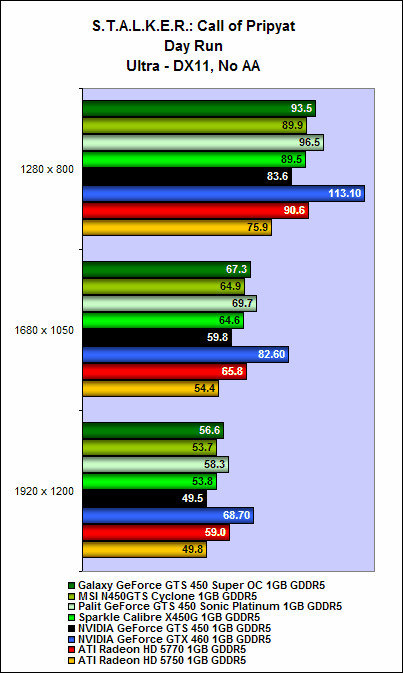 | 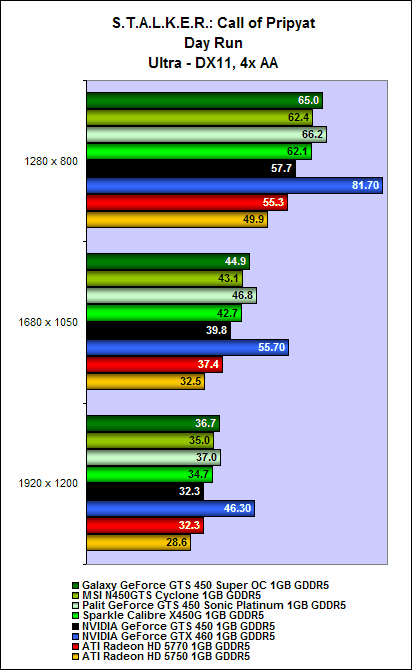 |
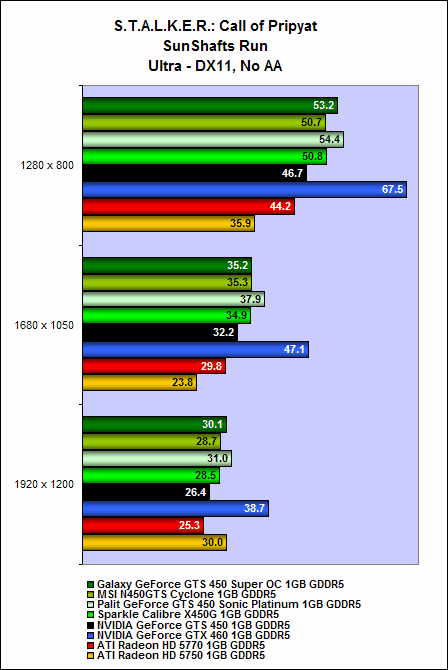 | 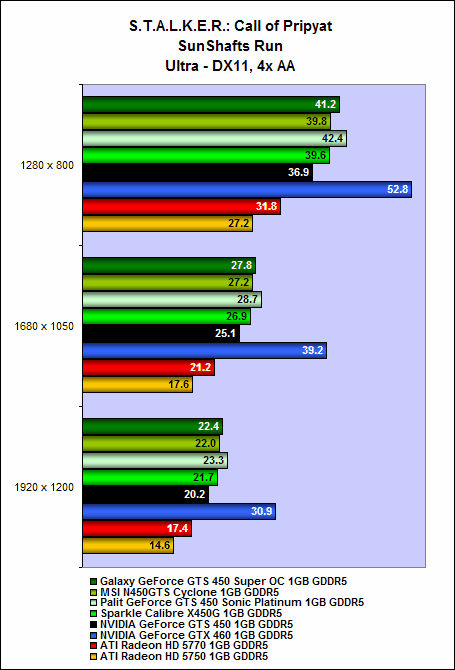 |
DirectX 10 Results
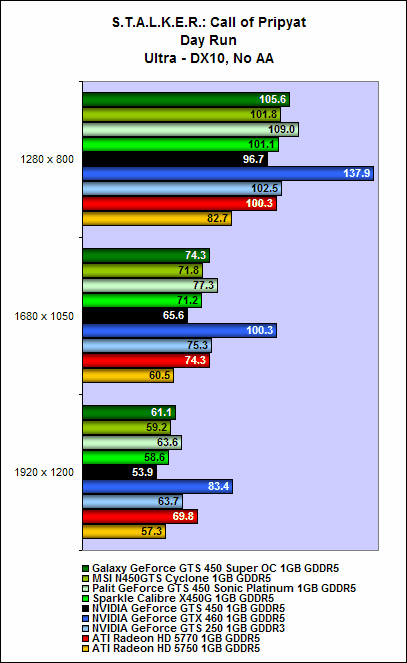 | 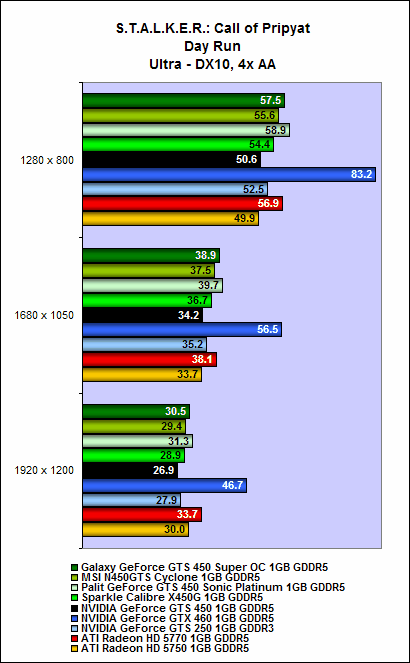 |
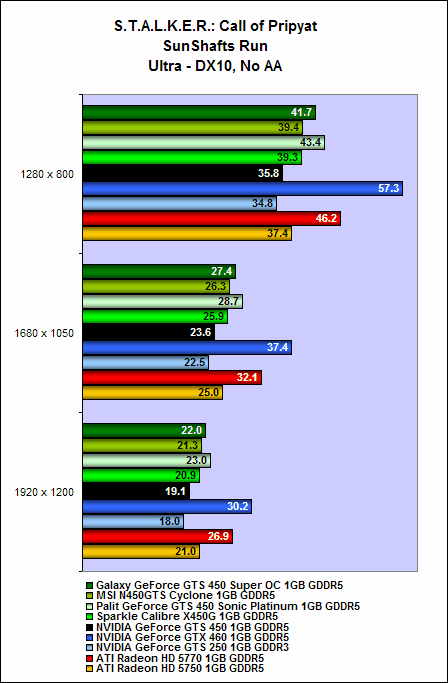 | 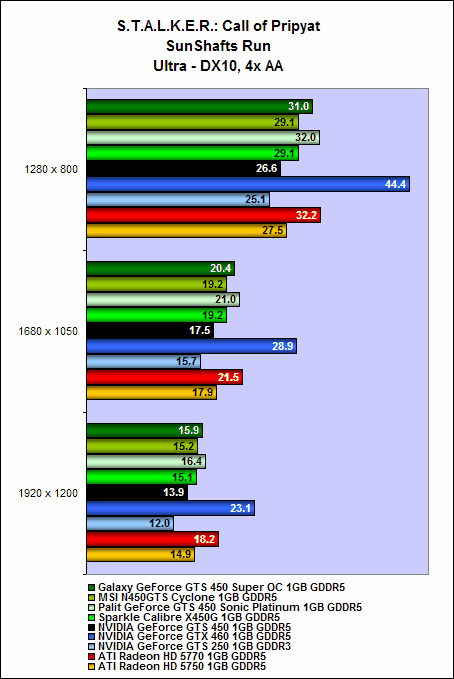 |
Temperature
It seems that size sometimes does matter, as the Sparkle Calibre X450G was the coolest card amongst the four, as we recorded an unbelievable 45 degrees Celsius even at load. The MSI N450GTS Cyclone wasn’t too far off the mark though, managing a respectable 49 degrees Celsius. The Palit GeForce GTS 450 Sonic Platinum, though fast, was the hottest card at 70 degrees Celsius.
As for the Galaxy card, we were informed that the BIOS was bugged in that it would not adequately increase fan speeds to the correct level when it detects that the card is under load. Hence, we were informed by Galaxy that we should set the card's fan speed at 40% for the test, since that's the level it should have increased to when it is under load. Galaxy also said that a fix would be on the way. With the fan speed set to 40%, the card recorded 67 degrees Celsius, a tad better than the Palit card.
We didn’t include results of the reference GeForce GTS 450, because we didn’t have a card with a reference cooler to properly ascertain the temperature.

Power Consumption
NVIDIA recommends a PSU rated for at least 400W and claims a maximum TDP of 106W for the new GeForce GTS 450. And from our results, that seems about right. Although our quartet of cards recorded similar idle power draw readings, the Palit and Galaxy cards and noticeably higher readings when at load, in particular the Galaxy card.
We didn’t include results of the reference GeForce GTS 450, because we didn’t have a reference design card to properly ascertain its power draw readings.

Overclocking
With its massive cooler, it wasn’t surprising to see the Sparkle Calibre X450G turn out tops in the overclocking states, achieving a maximum overclocking state of a full 1GHz at the core and 4000MHz DDR, giving it 5357 3DMarks in 3DMark Vantage - a substantial improvement of 13%.
Despite not doing too well in the temperature department, it seems that our Palit GeForce GTS 450 Sonic Platinum is blessed with a hardy chip as it managed a not too shabby 970MHz at the core and 4000MHz DDR, giving it 5291 3DMarks.
The Galaxy didn’t do too badly either managing 950MHz at the core and 4100MHz DDR, with a resultant score of 5277 3DMarks, an increase of 11% over its own score and a whopping 20% improvement over a reference GeForce GTS 450.
On the other hand, the MSI N450GTS Cyclone seemed to have drawn the shortest straw, because despite its effective cooler and the use of more efficient all solid capacitors, we could only manage 950MHz at the core and 4000MHz DDR, giving 5185 3DMarks.

Does the Job, But is that Good Enough?
Let’s begin our conclusion with the new GeForce GTS 450 SKU and then we’ll evaluate the individual cards.
Judging from our benchmarks, the GeForce GTS 450 delivers on its promises. Priced at around US$129 to compete directly with the Radeon HD 5750, it is convincingly faster than its ATI rival, by around 5% to 15%, especially when tessellation is enabled.
NVIDIA said it’ll handle 1680 x 1050 pixels resolution nicely, and it does. It manages to put out playable frame rates even with maxed out settings on newer games like S.T..A.L.K.E.R.: Call of Pripyat and Battlefield Bad Company 2, which is certainly impressive. And we’re sure that if users don’t mind turning down the graphics settings a notch, the gaming experience with the GeForce GTS 450 will be even smoother.
That said, the GeForce GTS 450 is surprisingly lackluster compared to the GeForce GTX 460. Even factory overclocked versions don’t come close to it. The GeForce GTS 450 is also some way off the mark compared to the Radeon HD 5770, but custom edition cards like the four we have here are be able to tackle and at the very least match the Radeon HD 5770 easily.
In the end, the GeForce GTS 450 is much less impressive than the GeForce GTX 460. Unlike the latter which could punch well beyond its weight, the GeForce GTS 450 is a bit more reserved in the performance stakes, although we are pleasantly delighted by its readiness to overclock. Also, improvements in power consumption and operating temperatures (with custom coolers) have been much improved. But given that both the Radeon HD 5770 and HD 5750 are already almost a year old, we would have expected nothing less from NVIDIA.
The GeForce GTS 450 is a solid card for gamers on a tight budget, but it doesn’t blow us away like the GeForce GTX 460 did. In all, it does the job which it set out to do well, but is that good enough? Because word on the street is that ATI (or AMD rather) is already prepping their new generation of cards, codenamed Southern Islands. Although nothing is concrete about Southern Islands at the moment, we’ll be surprised if AMD doesn’t release new cards by the end of this year, and hence we can’t help but feel that it might just be too late for NVIDIA.
Now on to the individual cards, but first a quick summary of its clock speeds and price.
Cards | Core Clock Speed | Shader Clock Speed | Memory Clock Speed | Price (USD) |
Galaxy GeForce GTS 450 Super OC | 888MHz | 1776MHz | 4000MHz DDR | $150 |
MSIN450GTSCyclone | 850MHz | 1700MHz | 4000MHz DDR | ~$140 |
Palit GeForce GTS 450 Sonic Platinum | 930MHz | 1860MHz | 4000MHz DDR | $150 |
Sparkle Calibre X450G | 850MHz | 1700MHz | 3700MHz DDR | $149 |
Cards | Performance | Features | Value | Overall |
Galaxy GeForce GTS450 Super OC | 8.5 | 8.5 | 8.0 | 8.5 |
MSIN450GTSCyclone | 8.5 | 8.5 | 8.0 | 8.5 |
Palit GeForce GTS 450 Sonic Platinum | 8.5 | 8.5 | 8.0 | 8.5 |
Sparkle Calibre X450G | 8.5 | 8.5 | 8.0 | 8.5 |

All four cards have their own pros and cons and it was nigh impossible for us to pick a favorite. It really depends on what you, the user, wants.
Like the other Palit cards with the “Sonic Platinum” moniker bestowed on them, the Palit GeForce GTS 450 Sonic Platinum is super fast. Running at a stunning 930MHz at the core, the card is capable of going head to head with the Radeon HD 5770 and is over 10% faster than a reference GeForce GTS 250. We also liked its selection of video output ports as it’s definitely more user-friendly than NVIDIA’s reference twin DVI and single mini-HDMI offerings.
Unfortunately, it also suffers the same problems as other Sonic Platinum cards, and that is heat. Although nothing to be worried about, Palit should revise the cooler, because right now, it is one of the hotter GeForce GTS 450 we have tested.
The Galaxy GeForce GTS 450 Super OC is a good match for the Palit card all round. The card might be slightly down in terms of clock speeds, but actually, it didn’t amount to much in terms of raw frame rates, so the two cards are actually very competitive. The Galaxy card also matches the Palit in terms of video output connectivity variety (but is short of a single DVI port) and also operating temperatures - both are just as hot to run. Finally, at US$150, the Galaxy card is also priced exactly the same as the Palit card, which makes it very hard to pick between the two. That said, the Galaxy does stand out with its unique easy to clean cooler and really, in the end, we think its really a matter of personal preference if you had to pick between the two.
MSI has decided to ditch introducing a reference version and went straight with a customized one and the MSI N450GTS Cyclone is a decent performer. It offers appreciably more performance than a reference card, but was no match for the Galaxy and Palit card. However, it redeems itself with its cooler, which was remarkably effective, maintaining the card at a cool 49 degrees Celsius even under load. And at a price of around US$140, it is also slightly cheaper.
Because the Sparkle Calibre X450G has comparable clock speeds with the MSI N450GTS Cyclone, the two cards were almost even matched in the performance stakes. But thanks to its massive custom cooler from Arctic, it was the coolest card in our roundup, recording an unbelievable 45 degrees Celsius at load. Because the card runs so cool, it was also our best overclocker, as we managed to get it to run at 1GHz at the core and 4000MHz DDR. But the massive cooler comes at a price, as the card costs considerably more than a stock card at US$150. Also be reminded that you'll need to keep three full expansion slots clear at the very least to accommodate this card into the system.
To sum, the four cards are very evenly matched. The Palit and Galaxy cards sacrifice thermal considerations for outright performance, whereas the MSI and Sparkle cards are incredibly cool to run, but are a tad slower. In the end, it really depends on what you want.
|  |
|  |
|  |
|  |
Our articles may contain affiliate links. If you buy through these links, we may earn a small commission.
